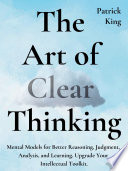

Cognitive biases are systematic patterns of deviation from norm or rationality in judgment. These biases can significantly affect how we process information and make decisions. The book emphasizes the importance of recognizing these biases in ourselves and others. By understanding cognitive biases such as confirmation bias, anchoring, and availability heuristic, individuals can learn to identify when their thinking may be skewed. This awareness allows for more objective decision-making and improved critical thinking skills. The author provides examples and exercises to help readers become more aware of their biases, encouraging them to question their assumptions and consider alternative viewpoints.
Continue readingClear communication is essential for effective collaboration and understanding. The book discusses the principles of clear communication, including the use of simple language, structured arguments, and active listening. Clarity helps to prevent misunderstandings and fosters a more productive environment. The author provides strategies for enhancing communication skills, such as organizing thoughts before speaking or writing, using visual aids, and encouraging feedback. By mastering the art of clear communication, individuals can convey their ideas more effectively and enhance their relationships both personally and professionally.
Continue readingCritical thinking is the ability to analyze information objectively and make reasoned judgments. The book outlines a structured approach to critical thinking, which includes identifying problems, gathering relevant information, evaluating evidence, and considering alternative solutions. The author emphasizes the importance of asking the right questions and being open to new ideas. By developing critical thinking skills, individuals can improve their problem-solving abilities and make more informed decisions. The book includes practical exercises and real-world examples to illustrate how critical thinking can be applied in various situations.
Continue readingEmotional intelligence (EI) refers to the ability to recognize, understand, and manage our own emotions and the emotions of others. The book explores how EI plays a crucial role in clear thinking and decision-making. High emotional intelligence enables individuals to navigate social complexities, resolve conflicts, and make better choices. The author provides techniques for enhancing EI, such as practicing empathy, self-regulation, and effective communication. By improving emotional intelligence, individuals can enhance their relationships and make more rational decisions, especially in emotionally charged situations.
Continue readingMindfulness is the practice of being present and fully engaged in the moment. The book highlights how mindfulness can improve clarity of thought and reduce cognitive overload. By practicing mindfulness, individuals can enhance their focus, reduce stress, and improve their overall mental clarity. The author suggests various mindfulness techniques, such as meditation, deep breathing, and mindful observation. Incorporating mindfulness into daily routines can lead to better decision-making and a more balanced approach to challenges.
Continue readingOur environment significantly influences our thinking patterns and decision-making processes. The book discusses how factors such as physical space, social interactions, and cultural norms can shape our thoughts. The author emphasizes the importance of creating an environment conducive to clear thinking, which includes minimizing distractions, fostering open dialogue, and encouraging diverse perspectives. By being mindful of their surroundings, individuals can enhance their cognitive performance and make better decisions.
Continue readingIn a rapidly changing world, the ability to learn continuously and adapt is crucial for success. The book encourages readers to cultivate a growth mindset, which involves embracing challenges, persisting in the face of setbacks, and viewing effort as a path to mastery. The author provides strategies for lifelong learning, such as seeking feedback, engaging in new experiences, and staying curious. By fostering a commitment to continuous learning, individuals can improve their clear thinking skills and remain relevant in their personal and professional lives.
Continue reading